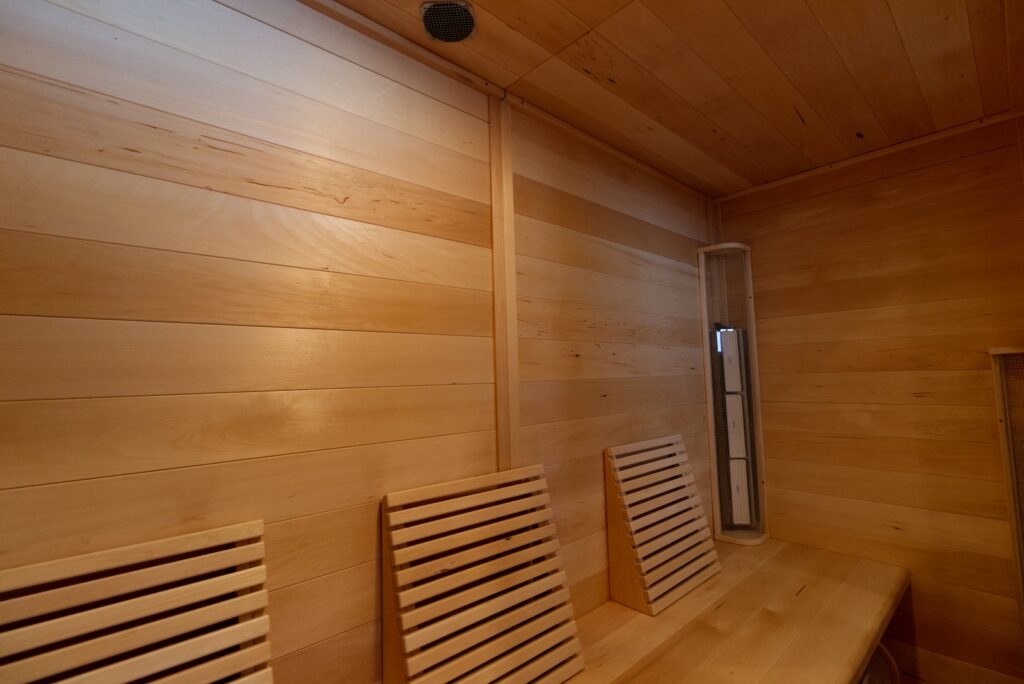Imagine stepping into a warm, steamy haven where the day’s stress melts away. Saunas have been used for centuries as a wellness sanctuary. Not only do they offer a soothing escape, but they also bring a slew of health benefits that wellness enthusiasts can’t stop raving about.
Saunas help detoxify your body and boost post-workout recovery. These days, even people adverse to intense heat can enjoy infrared saunas for similar benefits.
Experts recommend that you should ideally stay in a sauna for about 10 to 20 minutes at a time, paying close attention to your body for signs of dehydration.
At Recovery Lab, infrared sauna sessions are booked in half hour intervals. It may take a few sessions to tolerate the entire half hour.
The Science Behind Saunas & Their Benefits
When you sit in a sauna, your body’s temperature rises, causing your blood vessels to dilate. This process, known as vasodilation, improves blood flow and enhances oxygen delivery to tissues. Additionally, sweating may help remove toxins from your body, promoting detoxification.
The benefits don’t stop there. Other potential health benefits of saunas include:
- Reduced muscle soreness and joint pain
- Enhanced post-exercise muscle recovery
- Improved joint movement and flexibility
- Reduced risk of cardiovascular diseases
- Lowered risk of fatal cardiovascular events
- Temporary relief from psoriasis symptoms
- Enhanced weight loss when combined with diet and exercise
- Reduced asthma symptoms as your airways open
- Lowered blood pressure and stress relief
Different Types of Saunas
Saunas come in various forms, each offering unique features and benefits. The difference comes down to how the room is heated. These types include:
- Wood Burning: Traditional saunas use wood-burning stoves to warm the air and the rock. This creates low humidity with high heat, typically around 70°C to 90°C.
- Electrically Heated: Instead of burning wood, these saunas use an electrical heater to achieve the desired heat. They create low humidity and high heat—the same as wood-burning saunas.
- Steam: Steam rooms use moist heat, which can be gentler on the skin and respiratory system. They operate at lower temperatures, usually between 30°C and 50°C, but with high humidity levels.
- Infrared: Instead of warming the air, infrared saunas use infrared panels to directly heat your body. This allows for lower ambient temperatures, usually between 38°C and 60°C, making it a comfortable option for people who are more sensitive to heat.
Infrared Sauna at Recovery Lab
Infrared saunas are a modern twist on traditional sauna technology, using infrared light to generate heat. Unlike regular saunas that warm the surrounding air, infrared saunas directly heat your body, offering various therapeutic benefits even at lower temperatures. This unique heating method allows for deeper tissue penetration and can mirror many of the benefits of exercise—all without the stifling environment of standard saunas.
The health benefits of infrared saunas are impressive. They can help with muscle recovery, making them a favourite among athletes and active individuals. Regular use may also improve sleep, offer skin benefits, and provide relief from chronic pain. Many people appreciate infrared saunas for their positive effects on emotional well-being, helping to relieve stress and promote relaxation through the release of endorphins.

Optimal Time for a Sauna Session
You may know when to get into a sauna, but when should you get out to reap the most benefits? Staying in a sauna for too long can be dangerous, so you want to plan your time correctly. The proper duration can vary depending on the type of sauna, your specific health goals, and how accustomed you are to them.
Beginners should only use the sauna for 5–10 minutes at a time. This duration allows your body to acclimate to the high temperatures without risking dehydration or overheating.
Once you’re used to using a sauna, you may be able to stay in for up to 15–20 minutes.
Remember, a sauna should relax you. If you’re aiming for cardiovascular benefits, multiple short sessions with breaks in between can be particularly effective. Listen to your body and leave when you feel sufficiently hot. Everyone’s body is different, so you should stick to under 20 minutes in general.
Infrared saunas can be different. Because they don’t get as hot or humid as other types of saunas, they may allow for longer sessions. At Recovery Lab, sessions are booked in half hour intervals. It may take a few sessions to tolerate an entire half hour.
Tips On How to Safely Enjoy a Sauna
If you’re new to saunas, it’s vital to ease into the experience to ensure it’s both enjoyable and safe.
Start Slow
Begin with shorter sessions—about 5 to 10 minutes—and gradually increase your time as your body gets accustomed to the heat. This approach helps prevent overheating and dehydration. Also, wait at least 10 minutes after you finish exercising before entering the sauna.
Stay Hydrated
Drink plenty of water before, during, and after your sauna session. Saunas cause significant fluid loss through sweating, so keeping hydrated is crucial to avoid dizziness and dehydration.
Listen to Your Body
Pay attention to how your body feels. If you experience any signs of discomfort, such as dizziness, nausea, or extreme thirst, leave the sauna immediately and cool down.
Cool Down Properly
After your session, spend a few minutes cooling down. This can be done by taking a cool shower or simply relaxing in a cooler environment. Avoid jumping directly into a cold pool as it can cause your blood pressure to spike. Cooling down slowly helps your body return to its normal temperature safely.
Avoid Alcohol
Steer clear of alcohol before and after your sauna session. Alcohol can dehydrate you and impair your body’s ability to regulate temperature, increasing the risk of overheating.
Embrace Wellness Through Heat
Incorporating infrared sauna sessions into your wellness routine can be a game-changer for both your physical and mental well-being. At Recovery Lab, we proudly offer infrared saunas as part of our recovery programs. These saunas provide a comfortable way to enjoy all the benefits of traditional saunas without the stifling external heat.
If you’re ready to elevate your wellness routine, contact us today and explore our membership options to experience the incredible benefits of infrared saunas firsthand.
Happy sweating!



